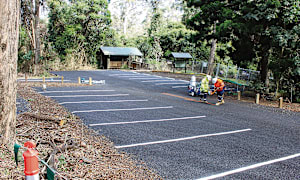
You can’t miss them, the burly dual-cab ute. It’s been called an ‘Aussie on wheels’, ‘dinosaur in the driveway’ and the monster vehicle in your rear view mirror during morning traffic.
In 2019, the Toyota Hilux drove into its fourth year topping the car sales ladder and the Ford Ranger came in second for the third year in a row.
More than 47,000 Hiluxes and more than 40,000 Rangers were sold outright in 2019 and the Mitsubishi Triton came in at the fifth highest selling car cementing three utes in the top five.
There’s some controversy surrounding the origin of the first ute, however many believe that it was invented in the Land Down Under.
Legend has it that a farmer’s wife from Victoria wrote to Ford in 1933 saying her family couldn’t afford two vehicles.
The farmers from Gippsland wanted a car that could take them to church on Sundays and transport the pigs to the market on Mondays.
And, in 1934, the first Ford Coupe Utility rolled off the production line.
The original ute had a 5ft 5in tray that could carry a load of more than 500kg and was undoubtably successful in its purpose.
Dealer Principal at Bremer Ford Ipswich, Paul Klease, said the first ute likely did come from Ford.
“Originally the Falcon was the first ute,” he said.
“We made utes in Australia until 2016, and four-wheel-drive utes have increased in number every year for the last six to seven years.”
Whether you prefer a Ford Falcon, Toyota Hilux or Mitsubishi Triton, there’s no doubt that it doubles as the Monday to Friday work truck and the weekend camping buggy.
Mr Klease says it’s the versatility of the vehicle that draws so many people to purchasing.
“I think it’s a good vehicle that covers recreation as well as work.
“I think as we all work harder and longer hours we look for that outlet, we want to have that lifestyle balance.
“People want a vehicle that they can put their kids in but also wake up on a Monday and do their work especially tradies and then on the weekend they want to go four wheel driving and camping.”
While many utes are purchased corporately for tax concessions on commercial vehicles, Mr Klease said the majority of people he sees are buying for recreational purposes.
“It’s increased a lot as a private person’s car. There seems to be a lot of families that have that as their first car and maybe a small SUV as their second vehicle,” he said.
And gone are the days of a bulky looking tradie tailgater, as the market for the ute grows, the vehicle has gentrified.
“They are becoming more car like, they are getting a lot more features as far as safety, comfort etcetera,” he said.
But Mr Klease added that the biggest catalyst for the increase this year has been Covid-19.
“It’s increased a lot during Covid, because you can’t travel overseas, a lot more people are looking to explore Australia,” he said.
“We’ve seen a lot of people buying four-wheel-drives to go holidaying and adventuring in our own backyard.
“We have stock shortages of certain models because of it.”
But Mr Klease said the bottom line is, it’s an Australian symbol.
“It’s been that vehicle for a long time that you can chuck something in the back, and park up and can sit on the back of it and have a beer with your mates,” he said.
“It’s been that iconic Australian thing and people want a part of that.”





